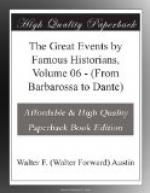At this period and for the rest of its history, the constitution of the Teutonic order embraced two classes of members—the knights and the clergy—both being exclusively of German birth. The knights were required to be of noble family, and, besides the ordinary threefold monastic vows, took a fourth vow, that they would devote themselves to the care of the sick and to fight the enemies of the faith. Their dress was black, over which a white cloak with a black cross upon the left shoulder was worn. The clergy were not necessarily of noble birth, their duties being to minister to the order in their churches, to the sick in the hospitals and on the field of battle.
To these two classes, who constituted the order, were added serving brethren, called Heimlike and Soldner, and in Latin, Familiares. Many of these gave their services gratuitously from religious motives; others received payment and were really servants. The knights selected their esquires from among the serving brothers. All these wore a dress of the same color as the knights, that they might be known at once to belong to the order.
The original rules of the order were very severe. All the members lived in common; they slept in dormitories on small and hard beds; they took their meals together in the refectory, and their fare was meagre and of the plainest quality. They were required to attend the daily services in the church, and to recite certain prayers and offices privately. They were not permitted to leave their convent, nor to write or receive letters, without permission of their superior. Their clothes, armor, and the harness of their horses were all of the plainest description; all gold, jewels, and other costly ornaments being strictly forbidden. Arms of the best temper and horses of good breed were provided. When they marched to battle, each knight had three or four horses, and an esquire carried his shield and lance.
The grand master was elected from the class of the knights only. Next in rank to him was the preceptor, or grand commander, who had the general supervision of the clergy and serving brethren, and who presided in chapter in the absence of the grand master. Next to the preceptor came the marshal, who acted as lieutenant-general in the field of battle under the grand master. The third dignitary was the grand hospitaler, who had the superintendence of the hospitals and of all that related to their management. The fourth officer was the trappier, who supplied the knights with their clothing and accoutrements. And, lastly, there was the treasurer, who received and paid all the money that passed through the hands of the order. All these officers were removable, and were commonly changed every year.
As the order extended, new functionaries were required and were appointed; namely, provincial masters of the several countries where the order obtained possessions, who took rank next after the grand master; and there were also many local officers as particular circumstances required. The grand master was not absolute, but was obliged to seek the advice of the chapter before taking any important step, and if he were necessarily absent, he appointed a lieutenant to act for him, who also governed the order after the death of the grand master till his successor was elected.




